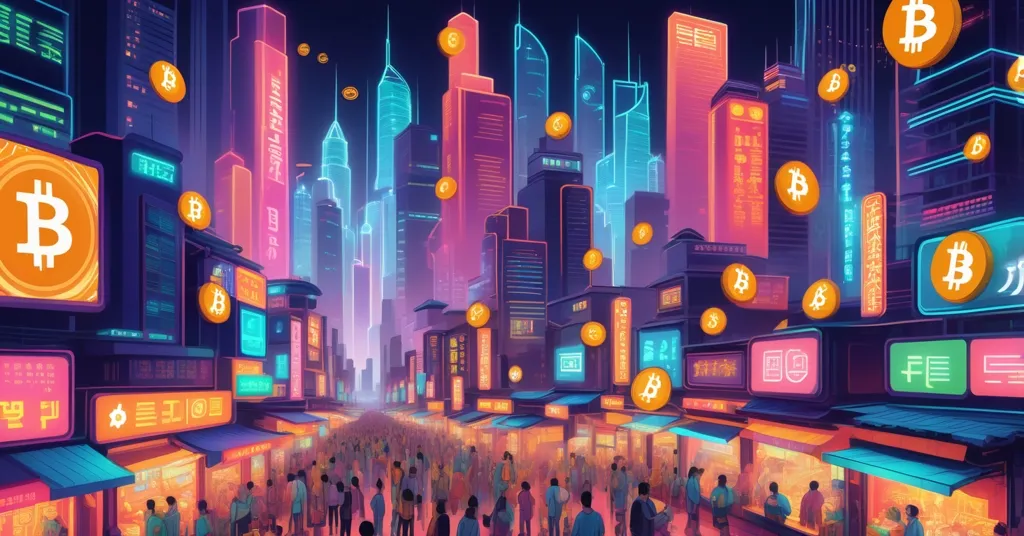Crypto Boom in Asia: 25% of Adults Invest as $BEST Presale Hits $17M

Crypto Adoption Explodes in Asia: 25% of Online Adults Invest as $BEST Presale Surges Past $17M
A seismic shift is underway in the Asia-Pacific (APAC) region, where nearly 25% of adults with internet access now hold cryptocurrency, marking a pivotal moment in the journey toward mainstream digital finance. Stablecoins are stealing the spotlight, while projects like Best Wallet, with its native $BEST token presale soaring past $17 million, aim to capitalize on this wave with user-friendly infrastructure.
- APAC Crypto Boom: Around 25% of internet-connected adults in Asia-Pacific own digital assets, driven by stablecoin utility.
- $BEST Presale Success: Best Wallet’s token sale hits $17M at $0.025945 per token, boasting 77% staking rewards.
- User-First Design: Best Wallet pushes to simplify crypto onboarding with multi-chain support and practical perks amid fierce competition.
APAC’s Crypto Surge: A Global Game-Changer
The Asia-Pacific region is cementing its place as the epicenter of cryptocurrency adoption. According to a joint study by Protocol Theory and CoinDesk, approximately one in four adults with internet access in APAC owns some form of digital currency, a trend highlighted in reports like this analysis of APAC crypto ownership nearing 25%. This isn’t just a statistic—it’s a cultural and financial tipping point. Countries like India, the Philippines, and Vietnam are leading the charge, fueled by high internet penetration (over 60% in many areas), mobile-first economies where smartphones dominate daily transactions, and a deep-seated need for alternative financial tools. In the Philippines alone, remittances from overseas workers account for nearly 10% of GDP, making crypto an attractive, low-cost solution for cross-border payments.
Stablecoins—digital currencies pegged to assets like the US dollar, such as USDT (Tether) or USDC (USD Coin)—are a key driver here. Unlike Bitcoin’s wild price swings, stablecoins offer predictability, making them a practical choice for hedging against local currency devaluation or sending money abroad without exorbitant fees. For millions in APAC, they’re not a speculative gamble but a lifeline. Yet, there’s a shadow over this utility: many stablecoins, particularly Tether, face scrutiny for lacking transparency about their reserves. Are they truly as “stable” as claimed, or just a shiny wrapper for centralized control? This tension between practicality and decentralization is a recurring theme in APAC’s crypto story.
Zooming out, this 25% adoption rate signals a market hungry for infrastructure that can turn curiosity into commitment. It’s no longer just tech-savvy early adopters; everyday people—street vendors in Bangkok, gig workers in Jakarta—are dipping their toes into digital assets. But with great opportunity comes great responsibility. The region’s rapid uptake also attracts scams, rug pulls, and half-baked projects looking to cash in. The question isn’t just how many are adopting crypto, but whether the tools they’re using uphold the principles of freedom and privacy we hold dear, or simply replicate the flaws of traditional finance in a new guise.
Stablecoins: Practical Tool or Hidden Risk?
Stablecoin dominance in APAC isn’t just a trend; it’s a reflection of real-world needs. In a region where local currencies can lose value overnight due to inflation or political unrest, a dollar-pegged token offers a semblance of security. Beyond personal use, merchants and small businesses are increasingly accepting stablecoins to sidestep volatile exchange rates. Data from Chainalysis shows that APAC accounts for over 40% of global stablecoin transaction volume, with USDT alone often outpacing Bitcoin in daily trades across regional exchanges.
But let’s not drink the Kool-Aid just yet. Stablecoins, while useful, often rely on centralized entities to maintain their peg—think Tether’s murky reserve audits or Circle’s ties to traditional banking. This raises a glaring contradiction for decentralization purists: are we trading one form of control for another? If a stablecoin issuer freezes funds or collapses (as nearly happened with TerraUSD in 2022, wiping out billions), APAC users—many of whom can’t afford such losses—bear the brunt. Bitcoin maximalists like myself see this as a cautionary tale: true financial sovereignty doesn’t come from pegged tokens but from trustless, censorship-resistant systems like BTC. Still, stablecoins fill a gap Bitcoin can’t fully address right now, acting as a bridge for the masses until broader volatility concerns ease.
Best Wallet Enters the Fray: Solution or Speculation?
With APAC’s crypto user base exploding, the demand for intuitive platforms is undeniable. Best Wallet, a non-custodial, multi-chain app, is positioning itself as a gateway for this growing demographic. For those new to the space, “non-custodial” means you control your private keys—no third party can access or freeze your funds, a core tenet of decentralization. “Multi-chain” refers to supporting various blockchain networks, from Bitcoin to Ethereum to emerging layer-2 solutions, ensuring users aren’t boxed into one ecosystem.
The app’s features read like a wishlist for both rookies and veterans: in-app buying and swapping of tokens, portfolio tracking to monitor gains and losses, and a fee structure that skips markups on base network costs (though network fees themselves still apply). A standout is its Token Launchpad, offering early access to crypto presales—high-risk, high-reward opportunities to invest in new projects before they hit public exchanges. Looking ahead, Best Wallet promises a staking aggregator to pool rewards across chains, protection against MEV (Miner Extractable Value, a practice where miners or bots reorder transactions for profit at users’ expense), advanced trading order types, and even a crypto card for real-world spending.
At the core of this ecosystem is the $BEST token, currently in the final 14 days of its presale, having raised over $17 million at $0.025945 per token. Holders can stake their tokens for dynamic rewards—currently a whopping 77%, though this will decrease as more tokens are locked up—mirroring DeFi (decentralized finance) trends where platforms incentivize participation with yield. Additional perks include fee discounts and priority access to new features, tying the token directly to the wallet’s utility.
The Hype vs. Hard Reality of $BEST and Beyond
Now, before anyone gets starry-eyed, let’s cut through the noise. Some analysts are floating predictions of $BEST reaching $0.60 by the end of 2026—a potential 23x leap from its presale price. That’s a tempting forecast, but let’s be real: it’s pure speculation, contingent on flawless execution, massive user growth, and major exchange listings. The crypto space is a graveyard of projects that hyped big numbers and delivered squat. Remember the countless 2021 presales that vanished after raising millions? Exactly. $BEST’s $17 million milestone is impressive, but it’s not a crystal ball. Our stance is clear—don’t fall for moonshot promises without hard evidence of delivery.
Even beyond price predictions, Best Wallet faces steep challenges. Multi-chain wallets, while versatile, are notoriously hard to secure—each supported blockchain adds a potential attack vector. Just look at past exploits on cross-chain bridges, where hundreds of millions have been stolen. Then there’s the roadmap: MEV protection and crypto cards sound great, but they’re untested at scale for most new entrants. Competing with giants like MetaMask or Trust Wallet, which already boast millions of users and battle-hardened infrastructure, is no small feat. Best Wallet’s focus on user experience is commendable, but trust in this space is fragile—one bug or breach could tank its reputation overnight.
Playing devil’s advocate, let’s also question the broader narrative. Is APAC’s adoption boom a triumph of decentralization, or just speculative mania in disguise? High uptake doesn’t always mean deep understanding—many users may be chasing quick gains or following trends without grasping the tech. And while stablecoins drive participation, their centralized underpinnings could undermine the very freedom crypto promises. Projects like Best Wallet might onboard millions, but if they prioritize growth over security or ideological purity, are we just building a shinier version of the same broken system?
Decentralization’s Promise and Perils in APAC
APAC’s 25% adoption rate is a clarion call for tools that empower users without exploiting them. Bitcoin remains the gold standard in our view—a trustless, censorship-resistant bedrock for financial sovereignty. But there’s space for altcoins and ecosystems like $BEST to tackle niches Bitcoin doesn’t directly serve, such as seamless onboarding or DeFi yield opportunities. The catch is execution: every new wallet, token, or protocol must prove it’s not just another flash in the pan or, worse, a scam preying on the uninformed.
As champions of effective accelerationism, we’re thrilled by the pace of innovation in regions like APAC, where crypto is disrupting outdated financial rails. Yet, our optimism is tempered by history—booms often breed busts, and the road to decentralization is littered with casualties. Best Wallet could be a piece of the puzzle, lowering barriers for the next wave of users. But it’s not enough to have a slick app or fat staking rewards; the endgame is freedom, privacy, and resilience. Whether $BEST and its ilk can deliver on that, or merely ride the hype cycle, remains to be seen. One thing’s certain: the stakes in APAC couldn’t be higher, and we’re watching with both hope and a healthy dose of skepticism.
Key Takeaways and Burning Questions
- What’s behind the crypto explosion in Asia-Pacific with 25% adult adoption?
Massive internet access, mobile-driven economies, and stablecoin use for remittances and stability are key, especially in nations like India and the Philippines facing currency volatility. - Are stablecoins a true step toward financial freedom in APAC?
They’re practical for payments and hedging, but centralized control (e.g., Tether’s opaque reserves) risks mirroring the flaws of traditional finance rather than dismantling them. - Can Best Wallet carve a niche among top crypto wallets?
Its non-custodial, multi-chain setup with in-app swaps and presale access targets ease of use, but competition from MetaMask and security risks pose massive hurdles. - Is the $BEST token presale worth its $17M fanfare?
Staking rewards at 77% and ecosystem perks are enticing, but speculative forecasts like $0.60 by 2026 are flimsy without proven results—history warns of presale pitfalls. - Does APAC’s crypto surge advance decentralization’s mission?
It shows demand for alternative finance, yet speculative behavior and centralized stablecoins could dilute the push for true sovereignty—genuine disruption demands vigilance.



